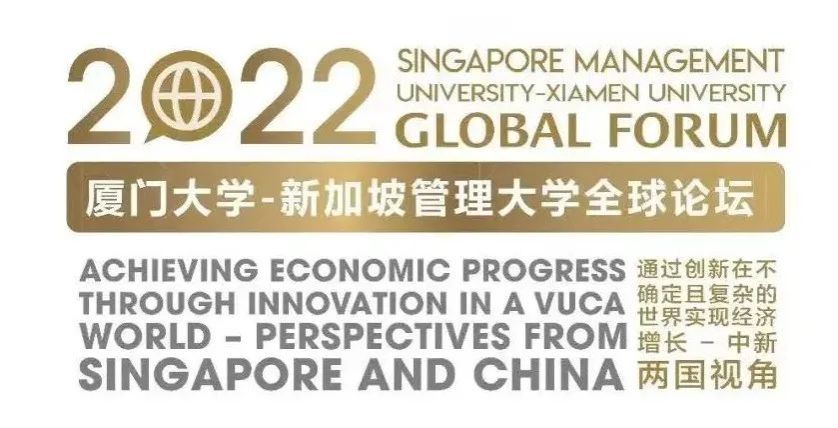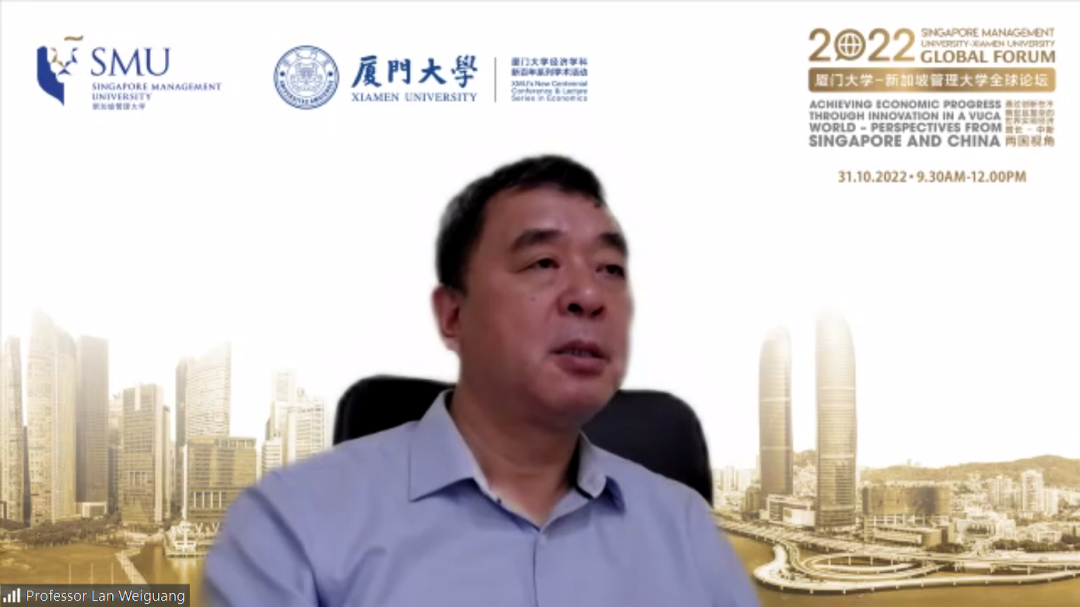10月31日,2022厦门大学-新加坡管理大学全球论坛在线上举行。新加坡驻厦门总领事吴俊明,厦门大学校长张宗益教授,新加坡管理大学校长江莉莉教授,新加坡官委议员、新加坡管理大学经济学院院长云天德教授,中国科学院大学经济与管理学院院长、厦门大学王亚南经济研究院创院院长洪永淼教授,新加坡国会议员、新加坡职工总会助理秘书长郑德源等知名学者与业界精英出席论坛。

厦门大学水科技与政策研究中心首席科学家、新加坡科技研究局杰出访问科学家、新加坡厦门大学校友会会长、中国科学院大学兼职教授、新加坡中国科技交流促进协会副会长、三达膜环境技术股份有限公司创始人蓝伟光教授受邀参加并作题为《创新的价值:为变幻莫测的世界提供增长的动力》的主旨演讲。

论坛语言为英文,论坛线上现场为听众提供了中英同声传译服务,论坛全程录制视频后续也将在网易和“央视频”上播出。蓝伟光教授的英文演讲实录及中文版翻译稿如下:
The Value of Innovation:Fueling Growth in a VUCA World
创新的价值:为变幻莫测的世界提供增长的动力
It is my pleasure to be invited to the Xiamen University-Singapore Management University Global Forum. The organisers had arranged for me to give a keynote speech, on a topic of my choice.
Since the conference is themed “Achieving Economic Prosperity through Innovation in a VUCA World – Insights and Experience Sharing from China and Singapore”, I thought why don’t I draw from my personal experiences to share two different stories of innovation, from Singapore and China respectively, to convey the value of innovation.
With that, I had a eureka moment. A topic that fits the forum’s theme came forth:"The Value of Innovation: Fueling Growth in a VUCA World".
When speaking about the unpredictability of this world, the most poignant example right now would be COVID-19. I would never have imagined that when I returned to Singapore on January 13, 2020 – the day after participating in the Forum on High-Quality Development of China's Economy at Xiamen University – I would end up not being able to return to China even till now, almost 3 years later.
However, even though the world has closed a door for humanity, it has opened another (virtual) window for all. I’m sure that the majority of the participants today would never have imagined that video conferencing would become so accessible and affordable today. This is the value of innovation.
Any discussion on innovation would be incomplete without disruptive innovation. Today, electric vehicles are increasingly popular, and their replacement of gasoline vehicles has become an irreversible trend. This is the power of disruptive innovation. The concept of disruptive innovation was originally derived from Schumpeter's "Creative Destruction", which Christensen later developed into "Disruptive Innovation".
Interestingly, although Schumpeter and Christensen are 69 years apart in age, they both taught economics at Harvard University. Hence, experts on innovation theories are usually economists, not scientists. Given that most of the guests participating in this forum today are economists, I feel humbled to be given the opportunity to speak about "the value of innovation".
Back to the main topic, let me start with the Singapore innovation story. All Singaporeans here must be familiar with the fact that when Singapore separated from the Federation of Malaya and gained its independence in 1965, Singapore’s founding Prime Minister Mr. Lee Kuan Yew, was most worried about the issue of water supply. He once said that, only when Singapore stops relying on Malaysia for its water supply, then can Singapore achieve true independence.
When I moved to Singapore 30 years ago to pursue my Ph.D. at the National University of Singapore, I was fortunate to have played a part in helping Singapore tackle its water supply issues, specifically, contributing towards the creation of NEWater.
As a result, I have received many honours in Singapore and have been cordially received by Mr. Lee Kuan Yew. Singapore's "Lianhe Zaobao" gave me the title "Membrane Master of Water Resources" and published a series of articles that I have written on the intersection of Water Technology and Policy.
Singapore's water story is a classic example of disruptive innovation, as it upends traditional notions of water resources. During a time when the world believed that sources of drinking water must be clean, safe and protected, Singapore utilised membrane technology to convert wastewater into drinkable water.
The innovative development and practical application of membrane technology allowed Singapore to add three National Taps: NEWater, seawater desalination, and collection and utilization of rainwater. Singapore can proudly claim that, despite being a small island surrounded by the sea, its capabilities in membrane technology have enabled it to achieve self-sufficiency in water supply. In the 1960s, Singapore signed two water supply agreements with Malaysia – one of which has been terminated and the other will not be renewed after it expires.
The second innovation story I want to tell is related to the electric vehicle industry I mentioned earlier on. As we all know, traditional vehicles rely on fossil fuels, while electric vehicles utilise lithium-ion batteries. Traditionally, lithium was sourced from lithium ores. This is because although salt lakes contain high amounts of lithium, magnesium is usually present as well, and at an concentration much higher than that of lithium. Hence, the traditional process of extracting lithium from salt lakes is highly inefficient.
Suntar took on this industrywide problem and tackled it as one would a scientific research problem. Our ability to apply reverse thinking and remain goal-oriented led to the innovation of a new salt lake lithium extraction process that utilises a combination of membrane and continuous ion exchange technology. Today, lithium extracted from salt lakes by this process has become the main source of raw materials for lithium batteries in China. Suntar also won nearly 500 million yuan worth of contracts this year with this innovative technology. The financial success of this technology is a testament to “The Value of Innovation”.
The only limit to innovation is our imagination. For example, Suntar’s research team has gone a step further to explore seawater as a possible and inexhaustible source of lithium. Recently, Suntar partnered with the National University of Singapore to bid for a $2.8 million R&D project – "Lithium Extraction from Seawater". Despite the fierce competition, Suntar and NUS emerged victorious and will be collaborating closely to tackle mankind’s great challenge of sustainable development.
Suntar is a research-driven company listed on the China Science and Technology Innovation Board. Suntar has built a unique RDPA model, which aims to provide an interactive platform connecting R&D and application and provide solutions that combine innovation and practice. At present, we have transitioned from the traditional approach of membrane technology development and application to an integrated approach that combines various technologies and processes, with membrane technology as the core. Through this integrated approach, Suntar strives to contribute to the world’s efforts in mitigating climate change and achieving carbon neutrality goals through innovation.
以下为中文翻译:
很高兴受邀参加厦门大学-新加坡管理大学全球论坛。论坛组织方安排我作一个主题演讲,但让我自己想一个演讲的题目。
我思考了一下,既然大会以“Achieving Economic Prosperity through Innovation in a VUCA World – Insights and Experience Sharing from China and Singapore”为主题,那我不妨以自己的切身经验,谈两个分别来自新加坡与中国的创新故事,以此诠释创新的价值。
由此,灵光乍现。一个契合论坛主题的演讲题目在我的脑中浮现:“The Value of Innovation: Fueling Growth in a VUCA World”, 中文可以把它译为:“创新的价值——为变幻莫测的世界提供增长的动力”。
说这个世界变幻莫测,最具代表性的莫过于新冠病毒对我们每一个人的影响了。我自己怎么也不会想到,我从2020年1月13日在厦门大学参加完“中国经济高质量发展高端论坛”的翌日回到新加坡,会经历至今近三年无法再到国内的尴尬。
然而,现实世界为人们关了一道门,但虚拟世界却为大家开了一扇窗。我相信,在座的参会者大部分人都不会想到今天视频会议会变得如此普及,而且如此廉价。这就是创新的价值。
说到创新,我们不能不提破坏性创新。今天新能源汽车风行世界,取代燃油车已经成为不可逆转的趋势,这就是破坏性创新的力量。破坏性创新的概念早先源自熊彼特的“Creative destruction”,后来克里斯坦森把它发展为“Disruptive Innovation”。
有趣的是,两位大师虽然相差69岁,但提出这个理论的时候,他们都在哈佛大学任教,是知名的经济学教授。由此可见,伟大的创新理论是由经济学家提出的,而不是科学家创造的。今天参加这一论坛的嘉宾大多数都是经济学家,我在你们面前谈“创新的价值”,实在惭愧,敬请海涵。
言归正传,下面我先来谈一个新加坡的创新故事。在座的新加坡人应该都很清楚,新加坡于1965年被迫离开马来亚联邦独立的时候,建国之父李光耀先生最担心的就是水问题。他曾经说过,唯有水供不再需要依赖马来西亚了,新加坡才有可能实现真正意义上的独立。
我很荣幸,三十年前从厦门漂洋过海下南洋、到新加坡国立大学攻读博士学位时,有幸参与了新加坡为解决水供问题所作的努力,并且为新加坡引以为傲的“新生水”的面世贡献了力量。
因此,我在新加坡收获了诸多的荣誉,受到李光耀先生的亲切接见。新加坡《联合早报》把我称为“水资源的膜法师”,该报也曾发表一系列我所撰写的“水科技与政策交叉渗透”的文章。
毫不夸张地说,新加坡的水故事是一个典型的破坏性创新的样本,因为它颠覆了传统的水资源概念。当全世界都认为饮用的水源必须洁净、安全、被保护时,新加坡却依靠膜技术,把用过的污废水转化成可以饮用的水。
正因为膜技术的创新开发与实践应用,新加坡增加了三个水龙头:新生水,海水淡化、雨水收集与利用。取得成功后,新加坡骄傲地向世界宣布,四面环海的岛国可以依赖科技实现水供的自给自足。上世纪六十年代,新加坡与马来西亚签订的两份水供协议,一份已经终止,另一份到期后也将不再续约。
我要讲的第二个创新故事,跟刚才讲的新能源汽车有关。众所周知,传统的汽车依赖化石能源,而目前的新能源汽车则以锂离子为核心。锂的来源早年主要来自锂矿石。虽然在盐湖中有大量的锂离子存在,但因为与镁伴生,而且镁离子的浓度远高于锂离子,所以传统的盐湖提锂工艺效率不高。
三达人把这一市场的难题作为科研的课题,逆向思维、目标导向,创新开发了基于膜分离与连续离子交换耦合的盐湖提锂工艺。如今,依靠这一工艺从盐湖中提取的锂,已经成为中国锂电池原料的主要来源。三达膜也因这一创新的技术及与之配套的工艺工程解决方案在今年斩获了近五亿元的合同,这正是创新创造价值的最佳写照。
梦想无限,创新无止境。进一步地,三达人把眼光瞄向了锂资源取之不尽、用之不竭的海洋。最近,三达膜与新加坡国立大学携手,在强手如林的激烈竞争中赢得了一个总预算280万新元的“海水提锂”研发项目,致力解决海水提锂面临的技术难题,应对人类可持续发展的巨大挑战。
三达膜是一家研发驱动发展的中国科创板上市公司。三达人构建了一个独特的“RDPA”模式,旨在构筑研发与应用衔接的互动平台,提供创新与实践耦合的解决方案。目前我们的研发课题已经从传统的膜技术开发与应用升级换代为以膜技术为核心的多种技术与工艺耦合的系统集成解决方案,旨在通过创新为世界解决气候变化、实现“双碳”目标贡献三达力量。
厦门大学—新加坡管理大学全球论坛旨在分享中国和新加坡在由创新实现经济可持续增长方面的见解和经验。两国为过渡至创新驱动型的经济增长而做出的努力面临着全球疫情、通货膨胀率上升和气候变化带来的挑战。因此,我们在关注长期政策措施的设计以激励创新的同时,也需要采取短期措施以应对面前的挑战。
厦门大学与新加坡管理大学携手,邀请学界知名学者与业界精英代表齐聚线上,以“通过创新在不确定且复杂的世界实现经济增长–中新两国视角”为主题,互相切磋,交流观点、碰撞思想,探讨创新在经济增长中的角色与作用。
(整理自 公众号“蓝伟光博士”)